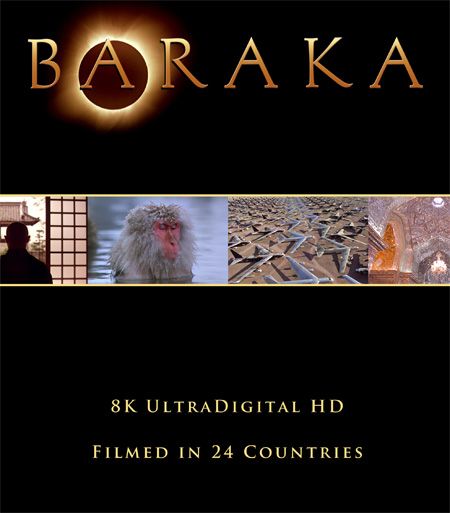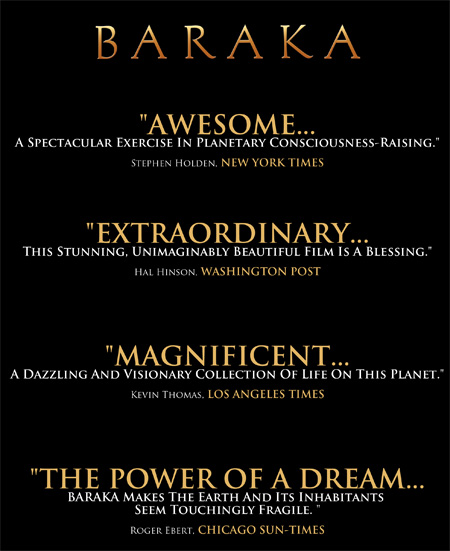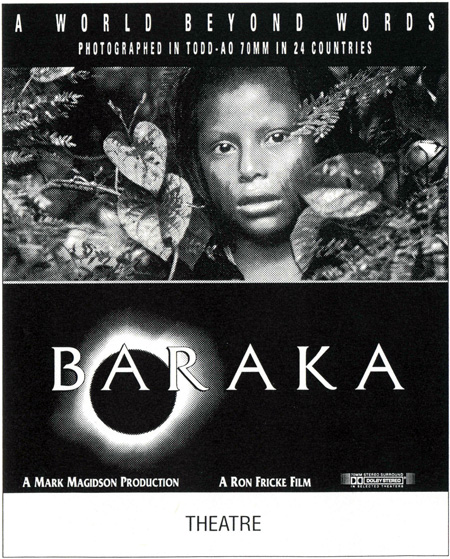"Baraka" The High Rez HD Digital lntermediate Restoration: HR/HD DI |
Read more
at in70mm.com The 70mm Newsletter |
| Written by: MPI Media Group | Date: 26.10.2008 |
 "Baraka" (1992), the classic 70mm non-narrative feature has just
completed a 16 month HD Restoration for its upcoming Blu-ray release in
Q3 of 2008 [28.10.2008, ed]. The beauty of the 70mm imagery and
compelling soundtrack has inspired many viewers around the globe. "Baraka" (1992), the classic 70mm non-narrative feature has just
completed a 16 month HD Restoration for its upcoming Blu-ray release in
Q3 of 2008 [28.10.2008, ed]. The beauty of the 70mm imagery and
compelling soundtrack has inspired many viewers around the globe.What makes this restoration different? This is the first time that a classic 70mm film has used the highest scanning resolution and the newest and best digital tools to create the highest quality Blu-ray release to date. This wasn't just done for the sake of the technology itself, but rather is an example of technology serving in its best capacity to enhance the creative story and imagery of "Baraka". While there have been some remarkable recent 70mm feature restorations for HD, none of them capture the true fidelity that's possible from the 65mm 5 perforation (65/5p) camera negative that produces those magnificent 70mm 5 perforation (70/5p) theatre experiences. It starts with the 65/5p camera negative that is 3 times larger than full frame anamorphic 35mm 4 perforation (35/4p) camera negative, or almost 5.5 times the size of a Super 35/4p frame. The producer, Mark Magidson, wanted a process that would capture that size and quality and translate it into a superior Blu-ray product. ...that process is Digital Intermediate (Dl). Digital Intermediate is the process of creating motion image content using digital technology regardless of the source or the destination. Dl had its origins in the late 80's as a Kodak digital alternative to the traditional photochemical intermediate process of IP/IN for the mass duplication and distribution of motion picture content. In the early days of the 90's, the limited capabilities, high cost, and slow speed of Dl restricted its use to visual effects and commercial projects with relatively large budgets. In the intervening decade, Dl, as with all maturing digital technologies, became faster, cheaper, and better. First, the A list features started to use the Dl tools, then music videos, then television programming, and now even independent features are using the technology. No longer restricted to the digital import and export of film product, Dl also now takes in a combination of sources including video and the new generation of digital cameras in HD, 2K, and 4K resolutions. The delivery can not only go back out to film, but increasingly is finishing as a digital source master that can be also be used to cross platform to a variety of digital displays such as digital cinema, HDTV, Blu-ray, and SO DVD's, and even to cell phones. The "Baraka" HD Dl & Restoration Workflow has taken the most advanced toolsets to create a final product that exceeds the quality of any previous feature film delivered to Blu-ray. Let's follow the path that Baraka took to maximize final image quality: |
More
in 70mm reading: "Baraka" Fully restored for Blu-ray "Baraka" cast and credits "Samsara" - in Panavision Super 70 / System 65 Publicity & Marketing MPI Media Group Dark Sky Films / Dokument Films 16101 S. 108th Ave. Orland Park, IL 60467 P: +1 708 873 3128 F: +1 708 873 3177 |
 Photochemical Preparation began with cleaning and repairing the 65/5p
original camera negative and creating a 70/5p Answer Print at FotoKem's
laboratory in Burbank, California. Photochemical Preparation began with cleaning and repairing the 65/5p
original camera negative and creating a 70/5p Answer Print at FotoKem's
laboratory in Burbank, California.Director/Cinematographer, Ron Fricke, personally supervised the color timing which was then used as the master color reference and the basis for creating a new wetgate 65/5p Interpositive. The 65/5p Interpositive would serve two purposes: it would be the source for scanning, as well as a preservation element to back up the original camera negative. When stored in a refrigerated archival vault, the Interpositive has an expected lifetime of 100 years. The 65/5p 8K scans were chosen as the highest resolution source that would take advantage of a well understood digital principal of oversampling, a technique often used in music mastering. Image oversampling produces a sharper looking final image when down converted, or down-rezzed, to a lower resolution. Once again, the production wanted the highest quality to convey the artistic brilliance of "Baraka". Most contemporary feature films scan and deliver at 2K resolution, and there is a trend for high end new and restoration projects to scan at 4K and deliver at 2K, and even a handful at 4K. No feature films have been entirely scanned at 8K until now. The file sizes change exponentially when scanning: a 4K scan is 4 times as much data as a 2k file, and an 8K file is 16 times as much data! The 8K scans of the Baraka 2.21/1 aspect ratio of the 65/5p Interpositive were 112 MB per frame and they were then down converted to 7 MB HO 1920 x 869 files...this resulted in an astounding oversampling ratio. This didn't come easily...there were 140,000 frames scanned at 13/secs per frame. FotoKem's one of a kind IMAGICA Bigfoot 65mm pin registered scanner took 3.5 weeks running 24/7, and produced over 30 TB of data. No new feature production could afford either the time or money to follow this path, but the payoff for the "Baraka" HD Restoration & Blu-ray release was that there was time and resources to do it, as well as a creative goal. |
|
 The HD Dl Restoration Process started with FotoKem's down conversion of
the massive 8K files to HD, a 16 to 1 ratio. Then Ron Fricke, the
director/cinematographer, started to work in the Dl suite to do primary
and secondary color grading. Working with the restoration producer,
Christopher Reyna, they identified myriad problems and shots that needed
the digital magic of Dl's multifaceted toolset. The restoration tasks
went from simple dirt and scratch removal to de-flickering, flare
removal, and the use of power windows and mattes to fix both problems
that originated in the camera, or that were the result of wear and tear
of the original camera negative. The restored HD Master is now seen in a
whole new way as a result of the Dl's unmasking and cleanup
capabilities. Fricke and Magidson were constantly amazed at the new
detail, color saturation, and contrast that he could now pull out his
photography. It was like looking at a restored Michelangelo fresco and
seeing a whole new painting with sense of wonder . The HD Dl Restoration Process started with FotoKem's down conversion of
the massive 8K files to HD, a 16 to 1 ratio. Then Ron Fricke, the
director/cinematographer, started to work in the Dl suite to do primary
and secondary color grading. Working with the restoration producer,
Christopher Reyna, they identified myriad problems and shots that needed
the digital magic of Dl's multifaceted toolset. The restoration tasks
went from simple dirt and scratch removal to de-flickering, flare
removal, and the use of power windows and mattes to fix both problems
that originated in the camera, or that were the result of wear and tear
of the original camera negative. The restored HD Master is now seen in a
whole new way as a result of the Dl's unmasking and cleanup
capabilities. Fricke and Magidson were constantly amazed at the new
detail, color saturation, and contrast that he could now pull out his
photography. It was like looking at a restored Michelangelo fresco and
seeing a whole new painting with sense of wonder .The restoration process continued as an interative exercise moving from one FotoKem department to another over a period of almost nine months. As each phase of the work was completed, it was quality controlled (QC) an on 18' [5,5 meter, ed] screen with a DCI compliant digital cinema projector, using the same standards of QC that one would normally use for a new feature release. Previous HD mastering workflows have typically relied on 32" CRT monitors for such quality control. But with the Blu-ray home theater market constantly expanding the size of their displays from the current average of 40-50 inches as well as moving to projection systems capable of 10 feet and larger, it was essential for the "Baraka" team to up-size our QC. It made a world of difference in improving the overall quality of the delivered HD master for Blu-ray. The digital soundtrack restoration was proceeding on a parallel path under the direction of the original designer, Michael Stearns. An early search and review of the original analog 6 track mix masters found that they had deteriorated. Stearns had no choice but to go back to his original 24 track tape elements and remix. Before transferring those 24 track tapes, they needed to undergo an overnight baking process to stabilize the oxide coatings. Stearns chose Widget Post for their unique oven and expertise to do this important work. After the completely successful baking, Widget converted the analog elements to digital. Stearns then took the new elements back to Santa Fe, New Mexico to complete the arduous and time intensive process of conforming and remixing to a new 24/96 digital printmaster. The accuracy, dynamic range, and noise reduction of the new digital remix is nothing short of incredible. Overall the "Baraka" restoration has done something that has never been done before and has established a new benchmark for the home entertainment industry. The High Rez HD Dl (HR/HD Dl) process has been used to create a new level of viewing and listening enjoyment that will define w hat the Blu-ray home experience can be. |
|
|
Go: back
- top - back issues
- news index Updated 22-01-25 |
|
